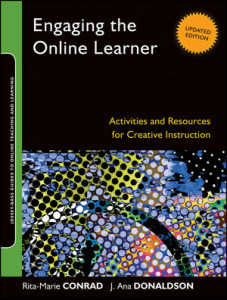Background: I teach online literacy courses, both undergraduate and graduate at The University of Texas at Arlington. I have been teaching online since 2008!
Drawing on ideas from Canadian scholar Terry Anderson and others (see here), a key foundation of online learning is to foster a Community of Inquiry (COI) where students are engaged not just cognitively engaged (which is what we often think learning is solely concerned with), but also socially engaged in a low-risk environment where the teacher is also virtually present in a variety of ways. A new book (2014) by Jon Dron and Terry Anderson, Teaching Crowds: Learning and Social Media (a free PDF can be located here) focuses on the COI framework on the wide vareity of social learning that can take place in an online course. I am looking forward to reading this!
In the meantime, a major goal of mine as an online instructor is to intentionally and strategically foster better student-student interaction to build a more solid foundation for discussions and interactions for students. Based on my readings of the following Jossey-Bass books, I started to implement the idea of “online icebreakers”. The two books that inspired me are below. They are quick reads! I made up most of the icebreakers myself, but several are variations on the icebreakers described in the books below and I have indicated this below.
Engaging the Online Learner: Activities and Resources for Creative Instruction (Rita-Marie Conrad and J. Ana Donaldson) Jossey-Bass Publishing, 2011.
Continuing to Engage the Online Learner: More Activities and Resources for Creative Instruction (Rita-Marie Conrad and J. Ana Donaldson) Jossey-Bass Publishing, 2012.
How to get started with Online Icebreakers
These go in the general discussion board area on my learning management system (Blackboard in my case). During week 1, or, prior to the course start, if you choose to open your learning management system up a bit earlier than the official course start date, students are required to post to at least one icebreaker (2-3 paragraphs). Writing a more extended post with more detail is required in the course I teach on writing; it has the dual purpose of helping students consider one of the icebreaker topics as a final writing topic for a key assignment in the course of creating a personal piece of writing. Students are required to post at least three comments to peers.
Each icebreaker is a separate thread within a forum labelled “Online Icebreakers”. Students reply as comments to to a thread; students do not create their own forums. Create one icebreaker topic for about every 5-10 students. E.g., I have 130 students in an online course, so I have about 15 icebreakers so any one thread is not too “crowded”. Choice is essential. So if you have 25 students, I recommend about 5-6 icebreakers. Encourage students to do more than one icebreaker; creating an initial post in response to one icebreaker is a minimum). I even get icebreaker ideas from social media. Encourage students to embed multi-media!
ONLINE ICEBREAKERS
Directions to Students: Complete at least ONE online icebreaker. Go inside this forum to view the icebreakers. Your initial post should be at least two paragraphs. This is a chance to get “warmed up” in terms of writing so do not be skeletal here. Try to include a multi-media element (optional) such as a link, picture, or screenshot of a Google Map (if you are doing “Location, Location, Location”).

